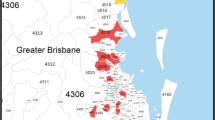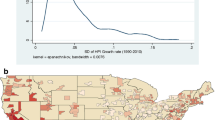Abstract
This paper outlines and applies a methodology for estimating and examining the variation in risk and return for individual homes. This is important because most households own individual properties and the risk and return profile of each of these may differ. We use large data sets of home prices and rents for Sydney, Australia, from 2002-16, and estimate flexible smoothing spline hedonic models. These models are used to construct total returns—the sum of capital gains and the rental yield net of costs—for the homes in our data. We find that Sydney homes had, on average, both higher returns than shares and much lower risk. This gave them a far superior Sharpe ratio. Moreover, while we find that shares benefit to a greater extent from diversification than homes, the Sharpe ratio of a large portfolio of shares was still well below that of the average single home. Interestingly, we find that much of the variation in risk and return across properties can be explained by observable home characteristics. In particular houses had stronger returns than did apartments.







Similar content being viewed by others
Notes
The urban areas are; Albury, Bathurst, Coffs Harbour, Dubbo, Gosford-Wyong, Lismore, Newcastle, Nowra-Bomaderry, Orange, Port Macquarie, Queanbeyan, Tamworth, Tweed Heads-Coast, Wagga Wagga and Wollongong.
Note here that our definition of a house is somewhat broader than a single family freestanding dwelling. We also include; terrace or row houses and semi-detached houses. These properties have land associated with them so are more similar to freestanding dwellings than to apartments.
Though, we note, there is still likely to be a degree of selection bias in the sold homes (Melser 2018).
A listing of the 200 companies used, and the industry in which they operate, can be found in the Online Appendix for this article. We selected companies on the basis of their market capitalisation in 2001Q4—the quarter before the start of our period of analysis. This should limit survivor bias in the returns compared with, say, selecting on the basis of market capitalisation in 2016Q4.
The data was obtained from the Securities Industry Research Centre of Asia-Pacific (SIRCA). SIRCA is a research collaboration amongst Australian universities originating in 1997 in order to provide comprehensive data for research in Finance. They have significant expertise in sourcing and constructing financial data.
For a fuller discussion of these issues see Hill and Melser (2008).
See, for example, those used by the Bureau of Economic Analysis in the US (www.bea.gov/national/pdf/BEA_depreciation_rates.pdf).
In Australia property investors are taxed on their net income from the rental properties they own. Hence any expenses are netted off rental income and lowers the owner’s tax bill.
We allow for the property to be untenanted for 2 weeks of the year. This is reasonable based on discussions with real estate professionals. However, it is a stylisation. Some properties will be vacant for longer than this and some for shorter periods. Our adoption of a constant vacancy rate is likely to lead to some attenuation of our estimate of the variability of returns to real estate, though this effect is likely to be modest. This attenuation appears unavoidable given that information on occupancy rates at the property-level are not readily available.
We explored various methods of averaging these values across homes—such as value weighting or taking the median—but it made little difference to the resulting numbers. This is consistent with the results in Melser (2018) who finds that weighting has only a modest impact on aggregate price change in housing price indexes.
We used this because such deposits are very low risk, given the high credit rating of Australian banks, and importantly they represent an investment which is easily accessible to Australian households. An alternative measure of the risk free rate is the 3-month overnight index swap rate. However, this is not a rate of return that can be readily accessed by Australian household. Nevertheless, the rate of return for this series is very close to that on a 3-month term deposit.
All assets here means for each asset class; all 469,567 Sydney homes, 211,131 Other NSW homes and 200 Australian shares.
The same spline regression models were estimated for each of these 15 urban areas as we have outlined for Sydney. The results have not been shown for brevity.
The Online Appendix provides a fuller discussion of our approach and a table and figure which parallel those of Table 4 and Fig. 7.
These results are discussed in detail in the Online Appendix which includes a table and figure like that shown in Table 4 and Fig. 7.
The calculation of these correlations is based on 100 random samples of the data. The standard deviation of these correlations is shown in the Online Appendix.
References
ABS (2006). Australian standard geographical classification (ASGC) remoteness area correspondences, 2006, catalogue no. 1216.0.15.003.
ABS (2011). Household expenditure survey, Australia: detailed expenditure items, 2009-10, catalogue no. 6530.0.
ABS (2012). Australian system of national accounts: concepts, sources and method, catalogue no. 5216.0.
ABS (2015). Australian national accounts: finance and wealth, Sep 2015, catalogue no. 5232.0.
ABS (2017a). Residential property price indexes: eight capital cities, June 2017, catalogue no. 6416.0.
ABS (2017b). Housing finance Australia, August 2017, catalogue no. 5609.0.
Bao, H.X.H., & Wan, A.T.K. (2004). On the use of spline smoothing in estimation hedonic housing price models. Real Estate Economics, 32(3), 487–507.
Beracha, E., & Skiba, H. (2013). Findings from a cross-sectional housing risk-factor model. Journal of Real Estate Finance and Economics, 47(2), 289–309.
Bostic, R.W., Longhofer, S.D., Redfearn, C.L. (2007). Land leverage: decomposing home price dynamics. Real Estate Economics, 35(2), 183–208.
Bourassa, S.C., Hoesli, M., Peng, V.S. (2003). Do housing submarkets really matter. Journal of Housing Economics, 12(1), 12–28.
Bracke, P. (2015). House prices and rents: micro evidence from a matched dataset in Central London. Real Estate Economics, 43, 403–431.
Case, K.E., & Shiller, R.J. (1989). The efficiency of the market for single-family homes. The American Economic Review, 79(1), 125–137.
Case, K.E., & Shiller, R.J. (1990). Forecasting prices and excess returns in the housing market. Real Estate Economics, 18(3), 253–273.
Case, K.E., Shiller, R.J., Weiss, A. (1993). Index-based futures and options markets for real Estate. Journal of Portfolio Management, 19(2), 83–92.
Davis, M.A., & Heathcote, J. (2007). The price and quantity of residential land in the united states. Journal of Monetary Economics, 54(8), 2595–2620.
de Haan, J., & Diewert, W.E. (2013) In et al. (Ed.), Hedonic regression methods, in OECD. Eurostat: Handbook on Residential Property Price Indices.
Federal Reserve Board. (2017). Flow of funds, balance sheets, and integrated macroeconomic accounts, second quarter.
Flavin, M., & Yamashita, T. (2002). Owner-occupied housing and the composition of the household portfolio. The American Economic Review, 92(1), 345–362.
Fox, R., & Tulip, P. (2014). Is housing overvalued? Reserve Bank of Australia, research discussion paper pp. 2014-06.
Francke, M.K., & Vos, G.A. (2004). The hierarchical trend model for property valuation and local price indices. Journal of Real Estate Finance and Economics, 28 (2), 179–208.
Gelfand, A.E., Ghosh, S.K., Knight, J.R., Sirmans, C.F. (1998). Spatio-temporal modeling of residential sales data. Journal of Business and Economic Statistics, 16(3), 3120–321.
Gelfand, A.E., Ecker, M.D., Knight, J.R., Sirmans, C.F. (2004). The dynamics of location in home price. Journal of Real Estate Finance and Economics, 29(2), 149–166.
Goswami, G., & Tan, S. (2012). Pricing the US residential asset through the rent flow: a cross-sectional study. Journal of Banking and Finance, 36(10), 2742–2756.
Harding, J.P., Rosenthal, S.S., Sirmans, C.F. (2007). Depreciation of housing capital, maintenance, and house price inflation: estimates from a repeat sales model. Journal of Urban Economics, 61(2), 193–217.
Hill, R.J., & Melser, D. (2008). Hedonic imputation and the price index problem: an application to housing. Economic Inquiry, 46(4), 593–609.
Hill, R.J., & Syed, I. (2016). Hedonic price-rent ratios, user cost, and departures from equilibrium in the housing market. Regional Science and Urban Economics, 56, 60–72.
Hill, R.J., & Scholz, M. (2016). Incorporating geospatial data in house price indexes: a hedonic imputation approach with splines, Review of Income and Wealth (forthcoming).
McMillen, D.P. (2003). Neighborhood house price indexes in chicago: a fourier repeat sales approach. Journal of Economic Geography, 3(1), 57–73.
Melser, D., & Lee, A.D. (2014). Estimating the excess returns to housing at a disaggregated level: an application to sydney 2003-2011. Real Estate Economics, 42 (3), 756–790.
Melser, D. (2017). Disaggregated property price appreciation: the mixed repeat sales model. Regional Science and Urban Economics, 66, 108–118.
Melser, D. (2018). Selection bias in home price indexes: revisiting Florida’s boom and bust. Discussion paper.
Ruppert, D., Wand, M.P., Carroll, R.J. (2003). Semiparametric regression. New York: Cambridge University Press.
Sharpe, W.F. (1963). A simplified model for portfolio analysis. Management Science, 9(2), 277–293.
Standard & Poor’s. (2017). S&P case-shiller home price indices index methodology, new york: standard and poor’s, http://us.spindices.com/index-family/real-estate/sp-case-shiller.
Wood, S.N. (2004). Stable and efficient multiple smoothing parameter estimation for generalized additive models. Journal of the American Statistical Association, 99, 673–686.
Wood, S.N. (2011). Fast stable restricted maximum likelihood and marginal likelihood estimation of semiparametric generalized linear models. Journal of the Royal Statistical Society B, 73(1), 3–36.
Acknowledgements
We would like to thank Australian Property Monitors (APM) for providing the housing data used in this study and SIRCA for the equity data. Thanks to Stephen Brown for comments on an earlier draft as well as participants at the 2017 European Real Estate Society (ERES) meeting in the Netherlands. We are grateful to the editor and referee who provided a number of valuable comments on the paper. All errors remain our own.
Author information
Authors and Affiliations
Corresponding author
Electronic supplementary material
Below is the link to the electronic supplementary material.
Rights and permissions
About this article
Cite this article
Melser, D., Hill, R.J. Residential Real Estate, Risk, Return and Diversification: Some Empirical Evidence. J Real Estate Finan Econ 59, 111–146 (2019). https://doi.org/10.1007/s11146-018-9668-x
Published:
Issue Date:
DOI: https://doi.org/10.1007/s11146-018-9668-x




